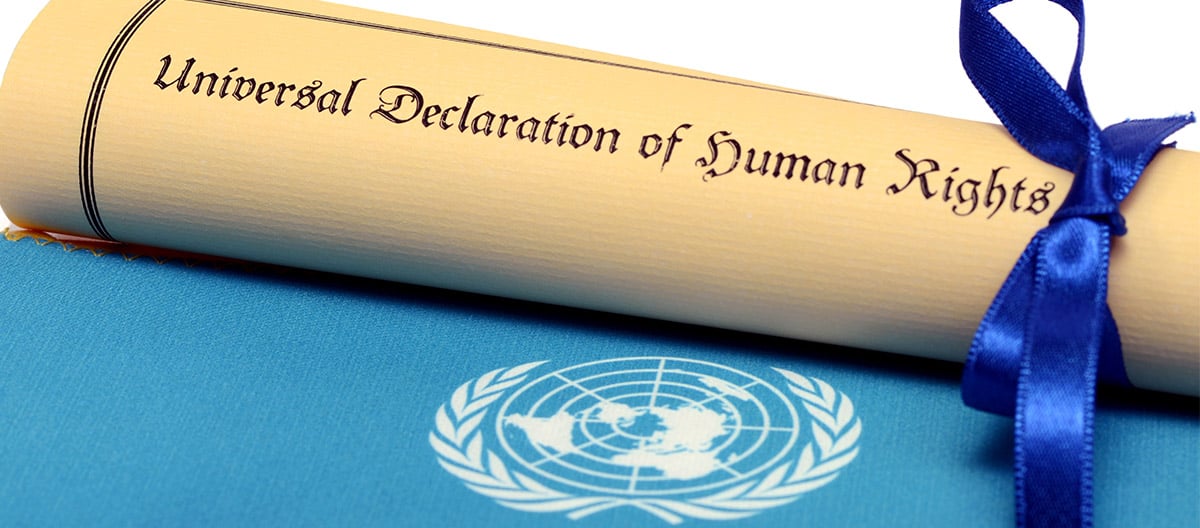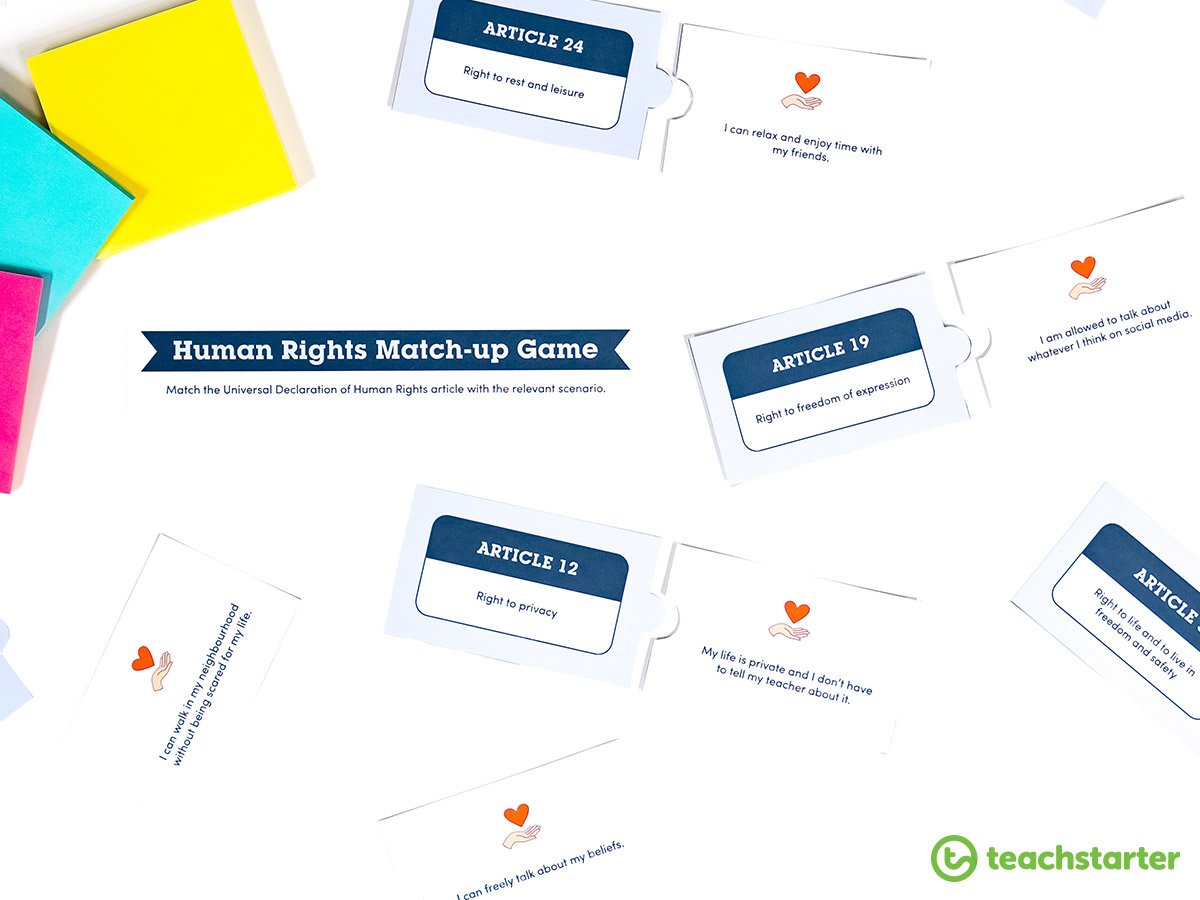What are human rights? It’s a question more and more kids are starting to ask as they see adults around them sporting “women’s rights are human rights” t-shirts and hear people on the news talking more and more about social justice issues. December presents a perfect time to talk about this challenging topic with our students and bring some human rights activities for kids into the classroom — after all, it’s Universal Human Rights Month. Add these activities to your social-emotional lessons or perhaps a social studies lesson.
Human Rights Activities for Kids
Educating kids about human rights is a way of protecting the fundamental freedoms many of us take for granted every day. Knowledge of human rights and the laws that protect all people gives the students the skills they need to promote, defend and apply human rights in daily life.
We’ve put together human rights activities designed to educate, inform, enlighten, and embolden kids from 5 to 15. There are a variety of activities you can do with the class which will give them a firmer grasp of what human rights are, why they are important and how to personally uphold and fight for what they represent. Let’s face it, in the wise words of Whitney Houston…
“I believe the children are our future. Teach them well and let them lead the way.”
The Universal Declaration of Human Rights Classroom Activity
A basis for any discussion of human rights, the Universal Declaration of Human Rights was developed by the United Nations as a common standard of achievements for all peoples and all nations.

The Activity: The Human Rights Magical Fruit Tree
Fruit trees typically produce only one kind of fruit, but a magical tree might produce a variety of unique and diverse fruits, much like the unique and diverse peoples of our earth.
In this activity, the students use the Create Magical Fruits Template to decorate unique fruit shapes to add to a Human Rights Magical Fruit Tree.
- Use classroom craft supplies to create a wall display of a tree complete with multiple branches and leaves.
- The students are to decide as a class, the human rights that they think all people need to live in dignity and justice.
- From the list, assign one human right to each student (or teams of students) to be included as part of their magical fruit design.
- When the designs are complete and the human right is written on the fruit, it can be added to the Human Rights Magical Fruit Tree.
As a follow-up activity, the class can match the fruits with articles of the Universal Declaration of Human Rights and write the number of the article next to each magical fruit.
Amnesty International Classroom Activity
Amnesty International is an international, non-governmental organization based in London. Their stated mission is to campaign for…
“…a world in which every person enjoys all of the human rights enshrined in the Universal Declaration of Human Rights and other international human rights instruments.”
This human rights activity for kids is built off of a free Amnesty International video that explains human rights from their perspective.
The Activity: The Human Rights Matching Game
There are 30 different articles in the Universal Declaration of Human Rights and it can often be difficult to understand how these articles relate to real-world events and situations.
- Have the students watch the Amnesty International clip What Are Human Rights?
- As a class, discuss the themes contained in the video. Use a mind-map on the board to record information relevant to human rights.
- Split the class into groups of 3 or 4, and distribute the Human Rights Matching Game cards (each group should receive a copy of all the cards).
- The students must then match the scenarios with the applicable human rights articles.
- Once each group has matched all the cards with an article, discuss the responses. Responses may vary, however, an answer sheet has been provided as a reference.
The matching game contains only eight of the 30 articles of the Universal Declaration of Human Rights.
As a follow-up activity, have the students create their own cards to find ways to link the other articles of the Universal Declaration of Human Rights to everyday activities in their lives.
UN Declaration of the Rights of the Child Classroom Activity
The United Nations Declaration of the Rights of the Child outlines, in language applicable for young kids, the rights of all children in the world as defined by the UN. Our United Nations Declaration of the Rights of the Child Flashcards outline each of the Rights of the Child.
Activity: Deconstruct YOUR Rights
In this activity, the students are tasked with a jigsaw collaborative learning task. In groups, the class will deconstruct one of the United Nations Declaration of the Rights of the Child and then present a poster, flyer, fact sheet or digital presentation to the class.
- Organize the class into groups of two or three (or whatever suits your cohort) so there are 10 groups.
- Distribute the United Nations Declaration of the Rights of the Child Flashcards, one for each group.
- In their teams, the students are tasked with creating material that will be given to the rest of the class to teach them about their particular right.
- To piece the jigsaw task together, as each group is presenting their children’s right, the rest of the class should take notes in their books.
- Show the class the YouTube clip United Nations Conventions on the Rights of the Child. Discuss how the United Nations Declaration of the Rights of the Child has progressed over the years to its present form, the Conventions of the Rights of the Child.
- On the board, begin three mind maps with the central bubbles being Dignity, Equality and Respect. From what the students have learned, brainstorm what these words now mean to the class.
As a follow-up activity, have the class look at the new simplified 42 articles of United Nations Convention on the Rights of the Child. Discuss the additions and changes and how they have improved upon the original 1924 document.
International Human Rights Day and the Nobel Peace Prize
December typically marks the Nobel Peace Prize celebrations and the presentation of the award.

Activity: Classroom Peace Prize
The idea of being a peace advocate is important for all students and is something which should be encouraged, recognised and rewarded in the classroom.
In this activity, each student is to prepare an acceptance speech for a Classroom Peace Prize to be presented at a mock awards ceremony. The students can pick from one of the following award categories to base their acceptance speech on.
- Altruism: showing selfless concern for others
- Care: desires to help people
- Compassion: feeling and showing sympathy and concern for others
- Consideration: thinking of others
- Faithfulness: being loyal
- Impartiality: treating all persons equally; fair and just
- Kindness: thoughtful, caring
- Politeness: exhibiting good manners
- Sincerity: being totally honest
In this activity, the students will take part in a mock awards ceremony in which each class member is a winner.
- Explain to the students that each individual is capable of showing at least one of the above personality traits. Give the class some time to discuss and finally choose the trait which is most suited to them.
- Display the Writing a Speech Poster on the board or monitor and discuss the structure of speech writing.
- Have the students plan, draft and edit their speeches. As their speech will be an informative text, you may like to hand out the Simple Informative Texts – Writing Scaffold.
- Choose from the Certificates and Awards collection on the Teach Starter website for an award theme best suited to this task. Ensure you have enough for each class member.
- Set aside enough time for each student to present their speeches. Explain to the class the rules to follow when someone is presenting to the class. Have each student present their speeches in front of everyone. For any students who are uncomfortable with a class presentation, give the option to have a fellow student read their speech or to have the teacher do it for them. This is not encouraged, however, as giving speeches is an important skill to practice and also a crucial element in the curriculum.
- Present all the awards once all students have completed their speeches.
As a follow-up activity, download the My Nobel Peace Prize activity which challenges students to write a paragraph about why they might receive the prize.









Comments